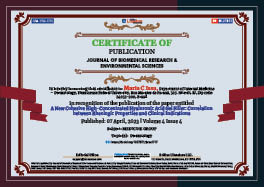Maria C Issa*, Andreia Fogaca, Eliandre Palermo, Marina Fontes, Hernane S Barud and Alessandra C Dametto
Volume4-Issue4
Dates: Received: 2023-03-24 | Accepted: 2023-04-06 | Published: 2023-04-07
Pages: 614-618
Abstract
Background: Differences among the Available Hyaluronic (HA) gels are relevant to clinical practice as the HA physicochemical characteristics guide cosmetic indications. Besides, the literature still needs more information about the correlation between the HA gel’s behavior through their rheologic parameters and clinical indications.
Objectives: We aim to evaluate the rheological properties of three gels with high concentrations of HA, e.p.t.q. S100®, S300®, and S500® (Jetema®) and extrapolate the results to their behavior after applied to the skin.
Methods: To correlate the physicochemical properties of e.p.t.q. gels to their possible clinical indications, three presentations of these gels were evaluated. The storage modulus (G’), loss modulus (G”), tan δ, complex modulus, viscosity, and cohesiveness were measured by rheology.
Results: The gels were non-Newtonian fluid with pseudoplastic behavior. All of them presented as elastic liquids (G’>G”). The S500 gel showed the highest G’ and complex modulus. S100 gel showed the highest tan δ and cohesiveness. S300 gel showed intermediary properties with tan δ and viscosity similar to the S500.
Discussion: Due to the high G’ and low tan δ, S500 gel is indicated for facial structuring and lifting. On the opposite, low G’ and high tan δ of S100 gel signal for refinement. The intermediate values of the S300 point it to lift or refinement.
Conclusions: According to the rheological results, we can assume that each gel has a specific indication, and the combination of S500, S300, and S100 enables a global facial treatment.
FullText HTML
FullText PDF
DOI: 10.37871/jbres1717
Certificate of Publication

Copyright
© 2023 Issa MC, et al. Distributed under Creative Commons CC-BY 4.0
How to cite this article
Issa MC, Fogaca A, Palermo E, Fontes M, Barud HS, Dametto AC. A New Cohesive High-Concentrated Hyaluronic Acid Gel Filler: Correlation between Rheologic Properties and Clinical Indications. J Biomed Res Environ Sci. 2023 Apr 06; 4(4): 614-618. doi: 10.37871/jbres1717, Article ID: JBRES1717, Available at: https://www.jelsciences.com/articles/jbres1717.pdf
Subject area(s)
References
- Pierre S, Liew S, Bernardin A. Basics of dermal filler rheology. Dermatol Surg. 2015 Apr;41 Suppl 1:S120-6. doi: 10.1097/DSS.0000000000000334. PMID: 25828036.
- Zerbinati N, Capillo MC, Sommatis S, Maccario C, Alonci G, Rauso R, Galadari H, Guida S, Mocchi R. Rheological Investigation as Tool to Assess Physicochemical Stability of a Hyaluronic Acid Dermal Filler Cross-Linked with Polyethylene Glycol Diglycidyl Ether and Containing Calcium Hydroxyapatite, Glycine and L-Proline. Gels. 2022 Apr 23;8(5):264. doi: 10.3390/gels8050264. PMID: 35621562; PMCID: PMC9140203.
- Kablik J, Monheit GD, Yu L, Chang G, Gershkovich J. Comparative physical properties of hyaluronic acid dermal fillers. Dermatol Surg. 2009 Feb;35 Suppl 1:302-12. doi: 10.1111/j.1524-4725.2008.01046.x. PMID: 19207319.
- Fagien S, Bertucci V, von Grote E, Mashburn JH. Rheologic and Physicochemical Properties Used to Differentiate Injectable Hyaluronic Acid Filler Products. Plast Reconstr Surg. 2019 Apr;143(4):707e-720e. doi: 10.1097/PRS.0000000000005429. PMID: 30921116; PMCID: PMC7597953.
- Carruthers J, Carruthers A, Humphrey S. Introduction to Fillers. Plast Reconstr Surg. 2015 Nov;136(5 Suppl):120S-131S. doi: 10.1097/PRS.0000000000001770. PMID: 26441092.
- Borrell M, Leslie DB, Tezel A. Lift capabilities of hyaluronic acid fillers. J Cosmet Laser Ther. 2011 Feb;13(1):21-7. doi: 10.3109/14764172.2011.552609. Epub 2011 Jan 21. PMID: 21254807.
- Edsman KLM, Öhrlund Å. Cohesion of Hyaluronic Acid Fillers: Correlation Between Cohesion and Other Physicochemical Properties. Dermatol Surg. 2018 Apr;44(4):557-562. doi: 10.1097/DSS.0000000000001370. PMID: 29059137; PMCID: PMC5902128.
- MEGÍAS-ALGUACIL, D. Characterization of the Linear Viscoelastic Region in Suspensionsof Zirconium Oxide: Cohesive Energy Obtained From the Critical Parameters. Applied Rheology. 2004;14:126-132.
- Cotofana S, Hamade H, Bertucci V, Fagien S, Green JB, Pavicic T, Nikolis A, Lachman N, Hadjab A, Frank K. Change in Rheologic Properties of Facial Soft-Tissue Fillers across the Physiologic Angular Frequency Spectrum. Plast Reconstr Surg. 2021 Aug 1;148(2):320-331. doi: 10.1097/PRS.0000000000008188. PMID: 34398083.
- Heitmiller K, Ring C, Saedi N. Rheologic properties of soft tissue fillers and implications for clinical use. J Cosmet Dermatol. 2021 Jan;20(1):28-34. doi: 10.1111/jocd.13487. Epub 2020 Aug 7. PMID: 32413205.
- Won Lee, Jh-Y, Ik-Soo Koh, Wook Oh, Ki-Wook Kim, Eun-Jung Yang. Clinical application of a new hyaluronicacid filler based on its rheologicalproperties and the anatomical site of injection. Biomedical Dermatology. 2018.






























































